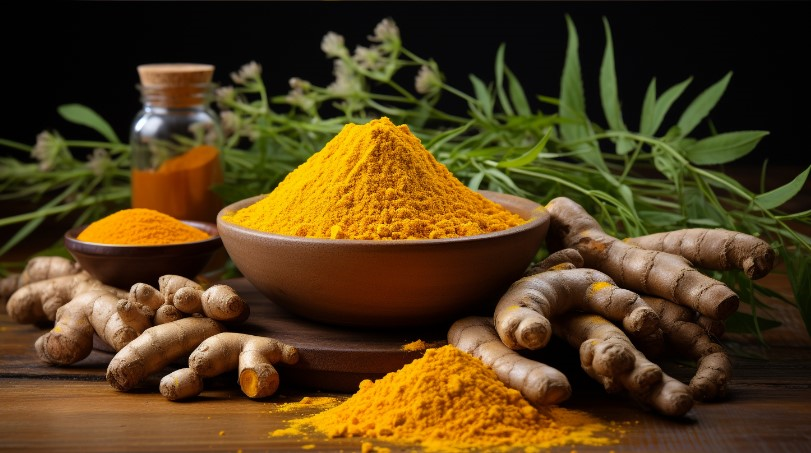A comprehensive explanation of curcumin

In recent years, as turmeric and its active compound curcumin have shown excellent health benefits in a large number of scientific studies, more and more people have begun to pay attention to and consume turmeric products.
In life, many people mistake turmeric for ginger, but turmeric is not ginger, and the difference between the two is still very big.
“Turmeric“, or yellow ginger, is a plant of the curcuma genus of the ginger family, native to India, is a plant herb with a history of more than 5,000 years, and has an important position in the Indian Ayurvedic medical system. In our country, it is also a more important traditional Chinese medicine. According to the Compendium of Materia Medica written by Li Shizhen of the Ming Dynasty, its medicinal properties are xin, bitter, major cold and non-toxic. In addition to wind heat, eliminate carbuncle, ancient recipe with turmeric to treat rheumatism caused by Bi pain, but also to treat heartache, and so on.
It is commonly used in some Southeast Asian regions, for example, when the roots are ground into powder, it becomes the main source of color and one of the spices in curries.
In addition to food, turmeric also has health and medicinal benefits because it contains a unique compound called “Curcumin”.
Curcumin health care value is very high, help relieve joint pain and stiffness, stable blood sugar, cell antioxidant, improve blood circulation, delay memory degradation and so on.
Curcumin is an effective antioxidant
Curcumin is thought to help the body’s own anti-oxidation and anti-inflammatory processes. [1] Oxidizing substances or free radicals can cause cellular damage and accelerate aging. Anti-oxidation substances, on the other hand, can prevent such damage.
The antioxidant activity of curcumin is better than that of vitamin C, vitamin E and beta-carotene.
Curcumin acts on both water-soluble and fat-soluble oxidants, as well as other types of harmful molecules. It is very helpful in preventing atherosclerosis (hardening of the arteries). [1]
Regulation of curcumin and NF-κB
In addition to preventing oxidation, curcumin has many other health benefits that may also help slow aging. Many of curcumin’s effects come from its effect on the protein complex NF-κB (nuclear factor activated B-cell κlight chain enhancer) in cells.
NF-κB is involved in cellular responses to stimuli such as stress, free radicals, heavy metals, radiation, and oxidized low-density lipoproteins. All of these stimuli can activate NF-κB and cause inflammation. Curcumin enhances the proper regulation of NF-κB to help optimize the body’s response to stress stimuli, helping to reduce inflammation and cell damage.
Curcumin and inflammation
Accelerated aging in humans is characterized by a state of chronic low-grade inflammatory response for several reasons. This process is often called “inflammation”.
Normally, the number and function of mitochondria decline with age. Because “inflammation” reduces cell energy, inflammatory compounds leak out of the mitochondria, and more cellular “waste” is formed inside the cell.
Decreased autophagy is another signature feature of aging and is closely related to mitochondrial function. As a result, the resulting cellular “waste” cannot be removed by autophagy, causing chronic inflammation.
Curcumin and joint health
A placebo-controlled study of mild to moderate knee discomfort found curcumin to be effective when combined with piperine. Over a period of six weeks, the subjects took 1,500 mg of curcumin Complex® daily, and the results showed a significant reduction in discomfort and optimization of physiological function. This dose of curcumin complex contains 15 mg of Bioperine® (a standardized piperine preparation). [2]
Although curcumin has many health benefits for the human body, it is difficult to achieve the desired effect by directly consuming “turmeric powder”.
Curcumin in turmeric powder is only 2-6%, curcumin is divided into curcumin C1, curcumin C2, curcumin C3.
Among them, “curcumin C3” has the largest anti-disease and other health care effects, but it accounts for the least, only 2%, equivalent to 1g of turmeric powder, only 0.0004g “curcumin C3”.
And our daily consumption is quite limited, and the curcumin that can really be absorbed and utilized by the human body is very small.
Turmeric powder has a low bioavailability
At the same time, because curcumin is a fat-soluble substance, if you want to improve the effectiveness and absorption of curcumin, you need to add oil to cook.
Curcumin is not easily absorbed by the human body when used alone (animal experiments found that the oral absorption rate is only 1%), so thanks to modern science and technology there are many formulas to enhance absorption, adding piperine (BioPerine) will slow down the metabolism of curcumin, and can effectively increase the bioavailability of curcumin by 10-30 times.
Although the above method can allow the body to absorb curcumin better, but the content of C3 in natural turmeric is always quite small, and the preparation of a lot of work, want to absorb enough “curcumin C3” from natural foods is not a convenient choice.
Therefore, the curcumin health care products on the market have become the choice of many people.
[1] Kunnumakkara AB, Bordoloi D, Padmavathi G, et al. Curcumin, the golden nutraceutical: multitargeting for multiple chronic diseases. Br J Pharmacol. 2017; 174 (11) : 1325-1348.
[2] Panahi Y, Rahimnia AR, Sharafi M, Alishiri G, Saburi A, Sahebkar A. Curcuminoid treatment for knee osteoarthritis: a randomized double-blind placebo-controlled trial. Phytother Res. 2014; 28 (11) : 1625-1631.
curcumin supplier: www.backvita.com
Email: [email protected]
Phone: +86 (029) 8187 2325
